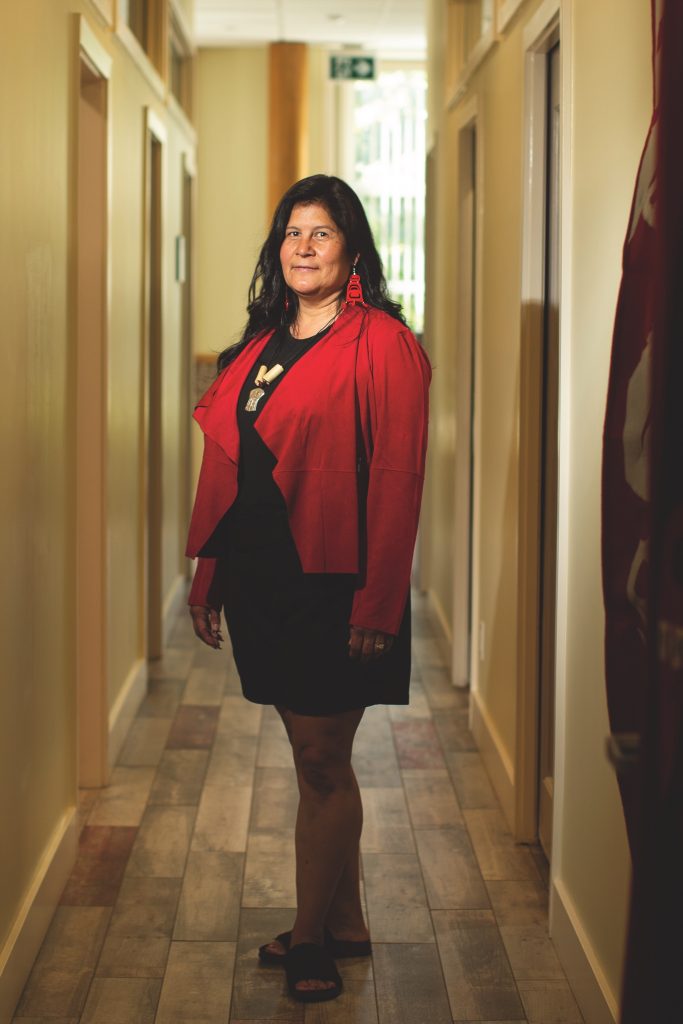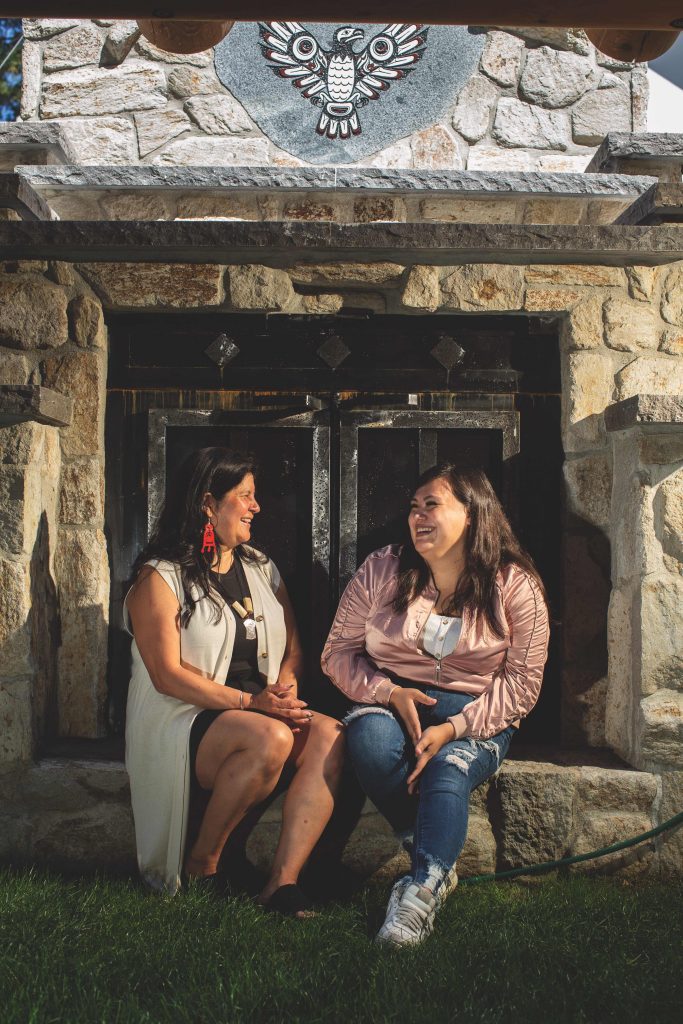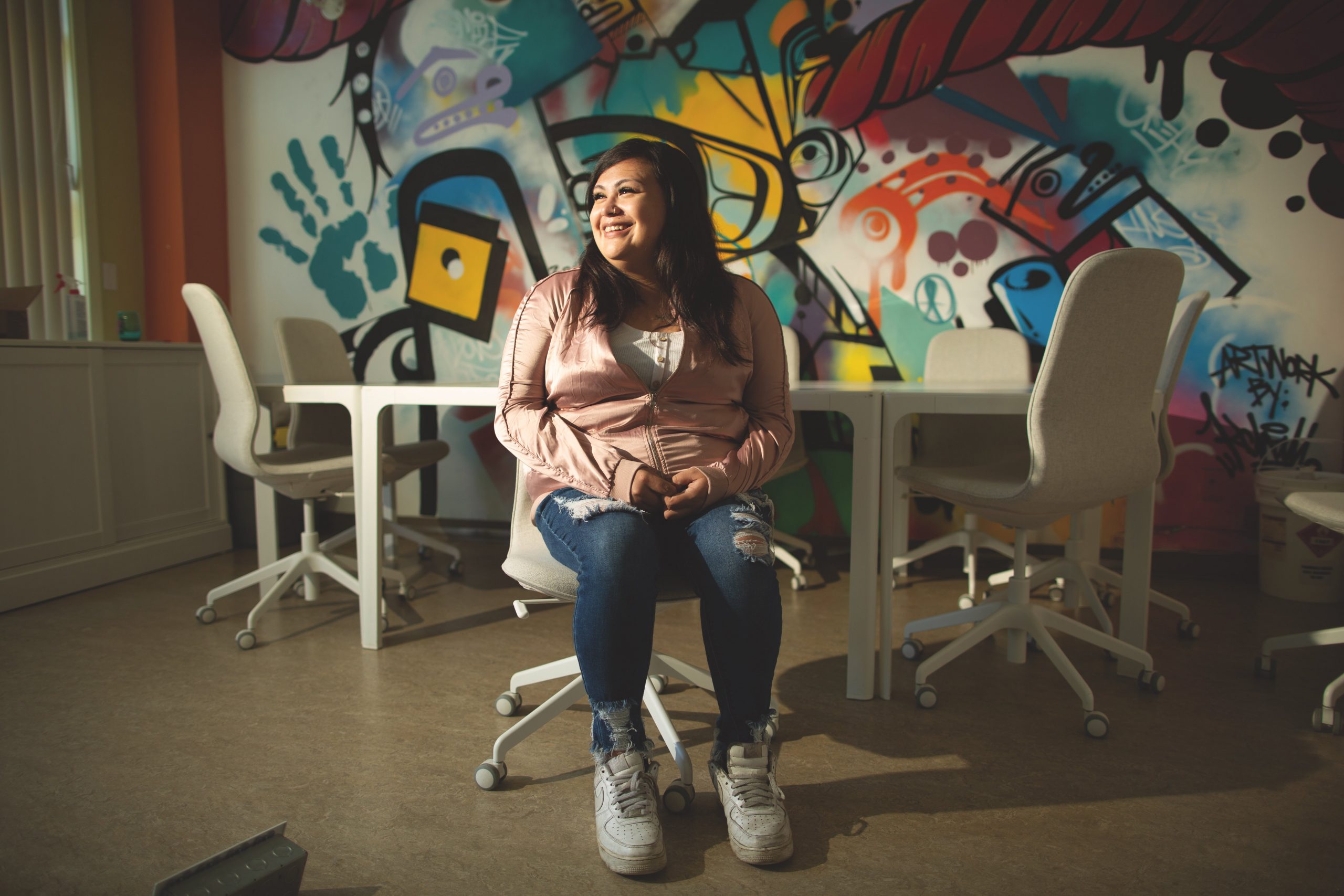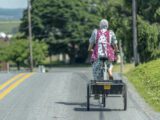All Kelli Smith-Henderson could think about the day she walked into a common room at the Lu’ma Native Housing Society in Vancouver was a looming deadline: her 19th birthday. In three weeks, Smith-Henderson would reach legal adulthood. Then she’d be pushed out of British Columbia’s child welfare system.
She’d join about 6,000 other children and youth across Canada who are abruptly cut off from government care every year. Although only eight percent of all children in Canada are Indigenous, they are vastly over-represented in the child welfare system. Half are Indigenous, like Smith-Henderson, who is Cree, Haida and Tsimshian.
You may unsubscribe from any of our newsletters at any time.
It was November 2016, and the lease on Smith-Henderson’s apartment was about to expire. Her daughter, Sofia, was less than two weeks old.
She was losing the legislated support British Columbia had provided since taking her into foster care at 15. She had nowhere to go. “I had no plan,” she says, wiping back tears as she remembers. “I didn’t know what to do — I felt really stuck.…The transition to being a grown-up from a youth overnight is really scary.”
For youth in care, becoming an adult is like plunging over a precipice. Unlike their peers with families to cushion the crises of young adulthood, few foster care alumni make it to college or university or into stable jobs.
If they do begin post-secondary education, they struggle to complete it. Based on the 2016 study Without a Home: The National Youth Homelessness Survey, youth who’ve had contact with the child welfare system are nearly 200 times more likely to be homeless after leaving care than their peers who lived with their original families. Many end up poor, addicted, struggling with mental health challenges or incarcerated. Others are trafficked.
Some don’t survive at all. From 2011 to 2016, young people leaving the province’s care “died at five times the rate of the general population of young people in British Columbia,” the BC Coroners Service found.
Fortunately, local organizations like Lu’ma in Vancouver and NiGiNan Housing Ventures in Edmonton have stepped into the gap. They offer wraparound services and support for Indigenous youth leaving government care. Their models offer a tantalizing glimpse into how scaled-up national or provincial programs could help these youth not only avoid the most harmful outcomes but also thrive in life.
For most youth jettisoned from foster and group care, the road to success is narrow. There are no national policy and funding initiatives for youth aging out of care in Canada, including Indigenous youth, whose welfare is a federal responsibility. No government agencies gather data or track the welfare of those transitioning from care.
During the height of the COVID-19 pandemic, most provinces placed moratoriums on forcing youth to age out of the child welfare system. This past spring, some provinces cautiously resumed transitions from care. The provinces and territories have a mishmash of programs for former youth in care. But the vast majority have what Varda Mann-Feder, a professor at Concordia University in Montreal who has reviewed these provincial programs, describes as “restrictive eligibility requirements.”
For example, Smith-Henderson dropped out of community college due to complications during her pregnancy. As a result, she didn’t qualify for British Columbia’s Agreements with Young Adults, a program that offers financial assistance to youth transitioning from care if they attend college, university or training programs.
In response to widespread negative experiences with aging out, the National Council of Youth in Care Advocates has proposed a suite of programs for youth leaving care that includes housing and a basic income. Alongside the Child Welfare League of Canada, the council is asking all provinces and territories to adopt these “equitable standards” voluntarily.
None of the federal or provincial governments has yet taken up the council’s call. But in March, British Columbia announced a three-year $35-million program and proposed amendments to child-protection legislation so no one in care will have to leave where they live when they turn 19. Youth will be able to stay in foster, group care or independent living arrangements until they are 21. The province is also hiring transition workers to better prepare youth for life on their own.
Youth will receive a monthly rent supplement of up to $600 when they leave care. British Columbia is also making it easier for youth to qualify for its young adult assistance program until they turn 27.
“We know that this group of young people is vulnerable. They’ve been traumatized,” says Mitzi Dean, B.C. children and family development minister, in an interview. “None of us who have children would actually expect our kid would be fully equipped to live independently and leave home at 19. We all, as parents…would be providing ongoing incremental support to help them achieve full independence. And so, as the parents of young people from care, we are doing that as a government.”

The changes British Columbia has announced do not give these youth family support, however. Finding youth housing and connections to community before or immediately after they age out of care is critical, says Cynthia Puddu, an assistant professor at Edmonton’s MacEwan University.
If adults don’t step in, there is the potential for gangs and human traffickers to make those connections that youth from care crave, says Puddu, who has studied youth homelessness and is involved in a collaborative research project with NiGiNan Housing Ventures. The “window of intervention” is short, she adds, noting that several unhoused youth have told her it only takes two to three weeks for youth to become entrenched in street life.
Barbara Lawson, manager of Lu’ma Native Housing Society’s youth mentorship program, was cooking chicken, asparagus and potatoes for a dozen former foster youth when she heard Smith-Henderson arrive. Lawson turned from the stove to welcome the anxious young woman hovering in the doorway. Another former foster youth asked if she could hold the baby while Smith-Henderson ate. Mercedes Fortney, a youth mentor with the program at the time, reassured her: “Don’t be shy. We’re your family now.”
For Smith-Henderson, the immediate sense of belonging brought a rush of emotion. Even now, at 24, the memory transports her back to the overwhelming panic she felt at aging out five years ago. When Lawson and the youth wrapped their support around her, Smith-Henderson’s anxiety eased.
“As soon as I walked in, I felt at home,” she says. “It felt like you came home from school, and your mom was cooking in the kitchen and your younger siblings were playing around. I never had that for my own family experience.…My years in foster homes — it was never like that.”
When Lu’ma opened its Aboriginal Youth Mentorship program in East Vancouver in 2014, it modelled the program’s goals after those of the Jim Casey Youth Opportunities Initiative. The U.S. policy and advocacy effort funds and supports local, state and federal organizations that help youth from foster care secure housing, pursue education, get jobs and find permanent families. The Jim Casey initiative now operates in 17 states, striving to improve the odds that the youth will transition to adulthood successfully.
The Lu’ma mentorship program takes a similar approach: it connects youth to adults and peers; links them to education, employment, housing and counselling resources; and provides access to an on-site medical clinic and 13 apartments specifically for Indigenous youth aging out of care. The program receives financial support from foundations and individual donors, and participants are referred by social workers, partner agencies and the youth themselves.
Together with her team, Lawson, who is Haida and Heiltsuk, threads cultural teachings throughout the program. She doesn’t require anyone to participate in a ceremony or cultural activity, however. “Because culture was forced on a lot of our youth that were in care, either in school or in the care system, none of them wanted to touch culture when they came into my program,” Lawson explains. (British Columbia requires foster families to connect Indigenous children and youth to their culture. Not all youth are comfortable with making those connections, however, in part because of childhood trauma.)
Lawson and a youth mentor are available and on-call 24/7, just like parents. The program’s mandate is explicit: “to be the extended family that our youth often do not have,” as it states on Lu’ma’s website.
Lawson is the heart of the program. The youth call her “Mom” or “Mama Bear.” Whatever she is prepared to do for her biological daughter, she is prepared to do for these young adults. “All of us need to take this approach,” she says. “We need to build a relationship with the youth that come into the program, and the relationship can’t be based on a service.”
Within three days of Smith-Henderson’s arrival at Lu’ma, Lawson had connected her to a housing worker, who helped the young woman apply for a $450-a-month rent supplement. This enabled Smith-Henderson to rent a room in a house with an aunt.
That was the start of five years of emotional and practical help. The relationships she made through the program gave Smith-Henderson the support she needed to transition to adulthood from foster care successfully.
When Smith-Henderson needed non-slip shoes and a uniform for a kitchen job, Lawson got them for her. If she was discouraged after a particularly bad day at college, she called Lawson for encouragement and a reality check. When Smith-Henderson got COVID-19, Fortney, then the program’s youth mentor, dropped off groceries and diapers at her door. Through Lawson and Lu’ma, Smith-Henderson found a family doctor. She also began counselling for her childhood trauma.
Several supportive housing projects for youth from foster care are springing up in other parts of the country. In Edmonton, NiGiNan Housing Ventures operates a multigenerational urban housing complex in the Belvedere neighbourhood in the city’s northeast. Like Lu’ma, the NiGiNan project, called omamoo wango gamik (All My Relations Lodge in Saulteaux), provides housing and wraparound services for about 10 Indigenous youth who have aged out of care, as well as for other at-risk First Nations and Métis youth.
The project is a partnership with the non-profit Right at Home Housing Society. Opened in fall 2020, omamoo wango gamik consists of a 42-unit affordable housing apartment and townhouse complex. Indigenous Elders live alongside single-mother families, families at risk of losing their children to the child welfare system, and former foster youth.
Carola Cunningham, NiGiNan’s chief executive officer, is a former warden at the Stan Daniels Healing Centre, a residential program for Indigenous men who are federal inmates or are released on conditions. Cunningham, who is Métis, has seen the consequences of not reaching youth from the child welfare system before addictions and street life consume them.
“If you don’t catch those kids, they will absolutely become the new homeless or the new inmates in provincial jail,” Cunningham says. “All those racist systems have an effect on these young people, and pretty soon they are broken. And it’s really a hard place to reach people that feel so broken.”
Kohkoms and mushums (grandmothers and grandfathers in Cree) help fill the parental void for youth from care at omamoo wango gamik. They provide live-in guidance and what Cunningham calls “wraparound kohkom support.” The multigenerational focus of omamoo wango gamik recreates traditional First Nations’ communities, Cunningham says.
Here, culture is a specific focus. Four Elders receive reduced rent in exchange for volunteering 16 hours a month. They lead ceremonies like smudging, as well as sharing circles, home visits, traditional parenting classes and time spent on the land. The Elders teach the former foster youth their roles as oskâpêwis (helpers in Cree).
Jesse Koenig is one of the youth Cunningham is trying to catch. A member of the Samson Cree First Nation, Koenig was just nine when the grandmother who was raising him died. Alberta’s Ministry of Community and Social Services placed him in foster care at age 11. He would go on to live in 32 different group homes, including a home for adults, Koenig says.
“All those racist systems have an effect on these young people, and pretty soon they are broken. And it’s really a hard place to reach people that feel so broken.”
Carola Cunningham
Although he is a talented musician who plays guitar with a band that has performed at Edmonton music festivals, Koenig never felt accepted in any of the places he lived. Koenig is a trans man and was often bullied. Group home staff considered him a lost cause, he says. “I kept on getting in trouble because of my anger,” he says. “I felt everyone was leaving me.…I just wanted a friend.”
At 18, Koenig aged out of Alberta’s child welfare system. Because he has fetal alcohol spectrum disorder and other developmental disabilities, he was eligible for provincial disability supports. But they weren’t enough to keep him afloat or give him lifelong connections. At 23, Koenig experienced homelessness after a landlord evicted him.
Eventually, he ended up at Ambrose Place, a housing complex that NiGiNan operates for the “absolutely hardest to house,” as Cunningham says. But Koenig says the environment wasn’t good for him. He describes residents with severe addictions, many struggling with their mental health. After he pushed a man he says was threatening him, Koenig ended up on probation.
When NiGiNan opened omamoo wango gamik, Koenig moved in. He has now lived there for almost two years. “I really like the building,” he says. “The people that I talk to — they’re okay. The staff are good.”
Koenig participates in a men’s group, the youth group and in ceremonies such as sweat lodges. He’s attended Elders’ teachings and has helped with ceremonial fires. “I’m actually learning a lot,” he says. “My mental health is stable lately.…I just want to put the message out there that no matter how tough your background was or is — you can overcome it. You can do it. Just don’t give up.”
Two provinces to the east, Courtney Law did not have a Barbara Lawson or a Carola Cunningham to catch her when the Manitoba child welfare system pushed her out of care. Law turned 18 — the age of majority in Manitoba — on Sept. 9, 2011.
Although she’s a member of the Liidlii Kue First Nation in Fort Simpson, N.W.T., Law has never been to Fort Simpson or met her biological grandmother, who lives there. At age 12, after a placement with her mother’s adoptive family failed, she came into the care of the Kinosao Sipi Minisowin Agency, a First Nations’ child welfare agency in Winnipeg.
At 15, Law was living in a Winnipeg foster home she shared with 14 others. She was sexually assaulted. She ran away and ended up at a youth shelter in the city that doubled as a group home.
During her three years at the shelter, the only preparation Law received for aging out of care was when a social worker had her fill out paperwork to begin enrolling in social assistance. “I didn’t know what I was going to do,” Law says. “I had nobody to ask for help.”
On her birthday, a worker gave Law city bus tickets. Then, because the shelter had a mandate to serve only youth under age 18, workers sent her on her way. Law spent that night curled up in an outdoor bus shelter, crying and clutching a garbage bag that held her few possessions. The next day, Law met people on the street who directed her to a Salvation Army shelter. She stayed there a couple of weeks until she got her first social assistance cheque. Then she found a rundown apartment in Winnipeg’s North End.

Social assistance provided $735 a month. The apartment cost $632, leaving Law with $103 to pay for food, a bus pass, hydro and her phone. Within a year of aging out, Law was selling drugs. “There was no other way for me to survive. I had no job skills. I had no resumé,” she says. “There were two options for me — sell weed or sell myself. I didn’t want to be like my mom, so I ended up selling weed.”
She was 19 when she unwittingly sold marijuana to an undercover police officer. She was arrested and sentenced to six months’ house arrest. When she violated the conditions, a judge ordered Law to spend the last month of her sentence in the Women’s Correctional Centre in Headingley, Man. In jail, Law met friends she knew from foster care. She estimates 80 percent of the inmates had gone through the child welfare system.
What’s known colloquially as the “care-to-prison pipeline” is well understood by workers in Canada’s justice and child welfare communities. There is little national research on the percentage of Indigenous youth from care who end up in prison. Last year, however, the Adoption Council of Canada (now the Child and Youth Permanency Council of Canada) released a report entitled Aging Out Without a Safety Net. The report included the results of a national survey and focus groups with young women+ who were about to or had recently aged out of care in Ontario, Manitoba, Alberta, Quebec and New Brunswick. Of the 107 participants in the project, 80 percent reported involvement with the justice system, and 27 percent had been arrested or spent time in jail.
Canada’s child advocates have been flagging the connection between aging out of foster care and the justice system for years. In British Columbia, Mary Ellen Turpel-Lafond, then the B.C. Representative for Children and Youth, and Dr. Perry Kendall, then the provincial health officer, examined the outcomes for children and youth in care as they pertain to the justice system.
Youth who had been involved in the child welfare system in British Columbia — many Indigenous — were 21 times more likely to have been convicted of a crime or jailed than their peers who had not been involved in the child welfare system, according to their 2009 report, Kids, Crime and Care. More youth in care are involved with the youth justice system than graduate from high school, the report also noted.
Courtney Law’s experience embodies those harms. Law, who participated in the Aging Out Without a Safety Net project, never completed high school. Her first stop when she got out of jail was an adult education centre so she could register for upgrading courses. But she has yet to graduate.
“My ADHD is too big of a barrier for me, and I wasn’t diagnosed until [age] 27,” she says. “I moved around so much I never got to finish a grade in one place.”
Today, Law, 28, is in a stable relationship and lives with her partner in Brandon, Man. She hopes soon to be able to care for her 12-year-old brother, who remains in foster care. She doesn’t want him to lose his cultural connections or to age out, like she did.
Increasing numbers of adult Canadians are living with their parents until age 29 or have moved home after leaving, as Law points out. “Kids who are taken away from their families before 18 are not taught anything, are kicked out at 18 and told, ‘Go make a life for yourself,’ she says. “How are you supposed to do that when you have absolutely no support?”
Law is wistful when she thinks about the difference wraparound services and a family atmosphere could have made for her. “To have a place, like an apartment building where kids could transition and live without worrying — that would have been a miracle.”
The miracle in Smith-Henderson’s life began the day she stepped into Lu’ma. Today, she has completed her diploma in early childhood education. She obtained her driver’s licence — a critical achievement on the life-skills scale that social workers and health-care professionals in North Amer-ica use to assess a youth’s readiness for independent living. She bought her first car. She’s raising her two children in a three-bedroom apartment she rents through BC Housing. Lu’ma helped move forward her application.
“Because of Barb and the program, I was pushed to do more and to believe in myself when I didn’t want to believe in myself. And now I have my education,” Smith-Henderson says, smiling proudly. She also got a job she loves as a family support worker at a women’s organization in Vancouver. “Without Barb or the program, I wouldn’t have done any of that.”
***
Laura Eggertson is a journalist in Wolfville, N.S., and a former executive director of the Adoption Council of Canada. A Michener-Deacon Fellowship supported her research for this article.
This story first appeared in Broadview’s October/November 2022 issue with the title “Aging out.”













